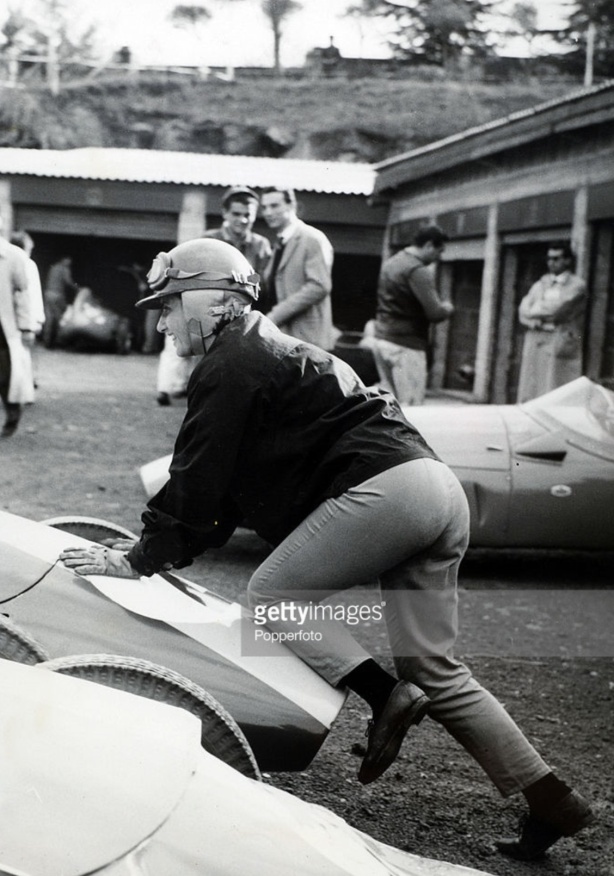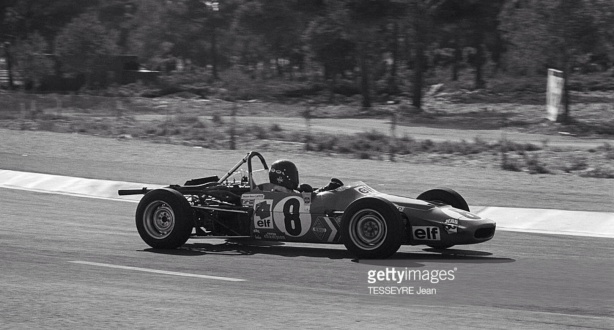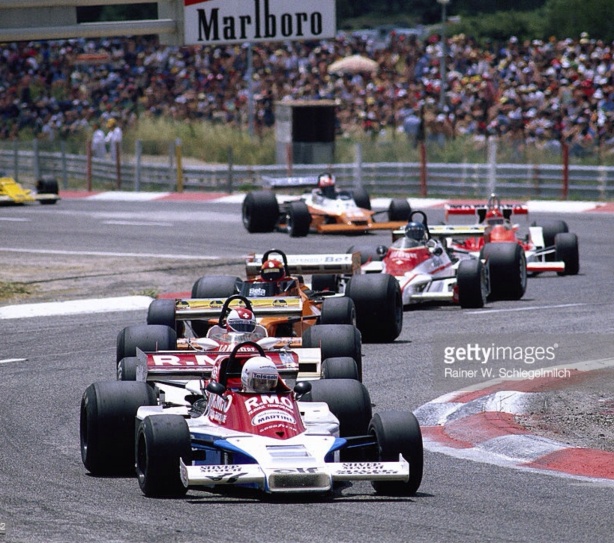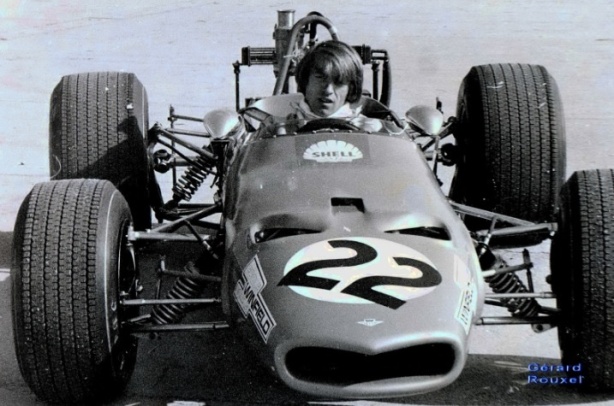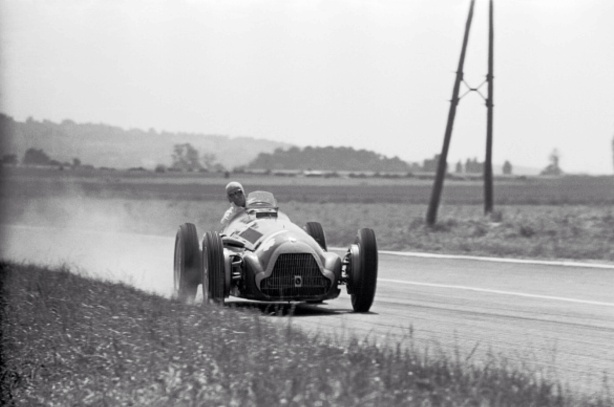Check out the view Maxxy!
Niel Allen and Max Stewart having a contretemps at Skyline, Mount Panorama, Bathurst, Easter 1969…
The bucolic terrain of New South Wales Central Tablelands stretches into the distance, the view probably not what the two drivers were focussed upon at the time. The race was the 1969 Bathurst Gold Star round, the field of which was substantially reduced by this first lap prang.
The incident happened when Max misjudged his braking behind John Harvey, locked a brake and boofed the fence in his Mildren Waggott 1.6. Niel was right up Max’ chuff in his ex-Piers Courage McLaren M4A Ford FVA 1.6 and couldn’t avoid him. Out of shot is Queenslander Glynn Scott’s Bowin P3 FVA who also joined in the fun!
Dick Simpson’s shot was taken at precisely the same time as John Arkwright’s (look at Max in each shot) albeit a bit further down the mountain. Its Leo Geoghegan’s Lotus 39 Repco framed by Allen’s wing with Glynn baring down on the action on the left and about to become a part of it.
Terrific shots both, ‘instant reaction’ stuff but beautifully framed all the same.

Nice butt shot of Harvey’s BT23E; note wing mounted to cars uprights at rear, ‘RB740’ ‘between the Vee engine’ and oil cooler up in the breeze (oldracephotos.com)
Here (above) is a shot of Harve’s Bob Jane owned Brabham BT23E Repco, it was Jack’s works ’68 Tasman car, sold to Bob at the end of the series then raced by John in the following years. In fact it wasn’t a lucky car for Harvey, he had a big accident at the same Easter meeting in ’68 when an upright broke, rooting the car and John. He was in hospital for quite a while after the prang, his speed undiminished when he returned to racing Jane’s stable of racers, sports-racers and tourers.
Click here for an article on this car;
https://primotipo.com/?s=brabham+bt23e
These fellas are favourites; property developer Allen was later as quick as Australia’s F5000 ‘Gold Standard’ Frank Matich without nearly as many seat miles, Stewart a multiple ‘Gold Star’ (1971/4) and AGP winner (19734/5) and Harvey a winner in everything he raced; speedcars, single-seaters, big sportscars and touring cars, the Bathurst enduro included.
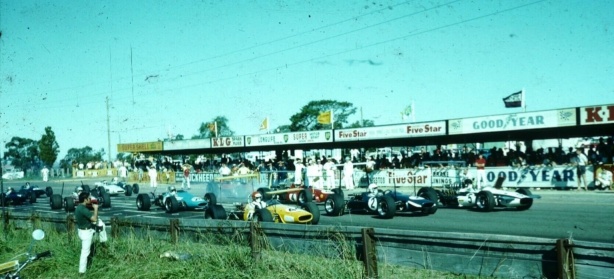
Start of the Bathurst ’69 Gold Star race: front row comprises Max’ yellow Mildren Waggott, Niel Allen McLaren M4A FVA and on the inside Leo Geoghegan’s Lotus 39 Repco. The blue car behind is Glynn Scott’s Bowin P3 FVA and Harvey’s red Brabham BT23E, the torque of which clearly gobbled up Stewart and Allen on the steep climb up the mountain for Max to nearly run into him heading down the mountain. The white car is Henk Woelders’ 3rd placed Elfin 600 Ford t/c. You can just see Jacks red Brabham on the outside beginning his charge. He had fuel feed problems in practice so was off grid 7 with times well below the cars potential (Neville McKay)
The race was won by Jack Brabham’s F3 based Brabham BT31 Repco on a rare Gold Star Australian appearance fitted into his European program. This little jigger was powered by a 2.5 litre ‘830 Series’ SOHC, 2 valve Repco V8. Easter Bathurst is an historically significant meeting in Repco terms; it was Jack’s last Repco race and win in Australia. Brabham’s last International Repco races were those contested by he and Peter Revson in the USAC Championship that year in Brabham BT25’s powered by Repco ‘760 Series’ 4.2 litre DOHC, 4 valve, methanol fuelled V8’s.
Check out, rather than repeating myself these articles on the BT31;
and on Brabham’s 1969 and 1970 seasons;
This article was inspired by Lindsay Ross uploading quite a few images of this meeting on his oldracephotos.com Instagram page, check it out, they pop up a post every day or so. It seemed an idea to put the images floating around of this meeting in one place. I’ve an Instagram page too, as well as Facebook, just key ‘primotipo’ into the respective search engines and follow the prompts. The FB page has quite a lot of shots I don’t use on primotipo so may be worth a look every few days.

Brian Page in BT23A with ‘740 Series’ Repco, DNF with broken exhaust on lap 15 in the ex-Brabham/Scuderia Veloce machine (oldracephotos.com)
The first lap accident ruined what could have been an interesting race, Jack cruised to an easy race win by 1.5 minutes from Harvey’s car and Henk Woelders F2 Elfin 600B Ford t/cam.
Historically interesting is that this meeting was on the weekend of 7 April 1969, high-wings were banned globally at Monaco on the GP weekend of 18 May 1969, so it’s interesting to see the ‘Australian State of the Art’ in terms of fitment of said aero devices immediately before they were banned. Brabham tried the ‘bi-wing’ below setup on his BT31 in practice but raced with only a rear wing fitted.
Of arcane interest, perhaps (from the master of the arcane and tangential) is that all of Jacks ‘works’ Repco engined Tasman cars competed in this race bar one…
Brian Page’s BT23A(1) is JB’s ’67 Tasman car, Harve’s BT23E(1) is the ’68 weapon and Jack raced BT31 the car, late arriving in Australia, which did the ’69 Sandown round only.
Missing is BT19(F1-1-65) the chassis in which Jack won the ’66 World F1 Drivers and Constructors titles, and in 2.5 litre ‘620 Series’ engined form, raced in the ’66 Tasman Series, putting valuable pre-GP season race miles on Repco’s ‘brand-spankers’ V8 at Sandown and Longford.
The only car not in Oz now is BT23E(1) which was, and still may be in the US.

Jack Brabham guiding BT19 (F1-1-65) into The Viaduct, Longford on his way to 3rd place during the South Pacific Trophy on 7 March 1966, the third race for the new RB ‘620 Series’ V8. The race was won by Jackie Stewart’s BRM P261
Whilst on the arcane it occurs to me is what a versatile, influential and successful design Ron Tauaranac’s BT23 space-frame was in the Brabham Pantheon…
’twas Ron’s clean sheet design for the new for ’67 1.6 litre European F2; it’s variants won a million F2 races over the following years in the hands of aces like Rindt but also in the care of privateer ‘coming-men’. Mind you it didn’t ever win the title despite winning 6 of the ten championship rounds in 1967, ‘graded drivers’ like Rindt were ineligible for championship points. Matra and Lotus took the ‘works entry’ approach more seriously than Jack and Ron during these years, in any event, as a customer racing car the BT23’s won lotsa races, the 1968 Rindt driven BT23C the most successful car of the year.

Jochen Rindt typically all ‘cocked up’ on the way to a win in the 9 July 1967 ‘GP de Rouen-les-Essarts’, Brabham BT23 Ford FVA. 1.6 litre F2 formula one of great chassis, it not engine diversity, Ford’s Cosworth FVA won every title from 1967 to 1971. F2 was 2 litre from ‘72 (unattributed)
From an F1 perspective the ’67 World Championship winning BT24 Repco was a ‘beefed up’ BT23, to the extent that Ron initially raced his BT24’s with an FT200 Hewland, the Maidenhead gearbox gurus ‘F2 box’ but found that tranny overstressed with ‘740 Series’ Repco V8 torque tearing away at its gizzards, its CWP in particular. I won’t bang on about the BT24 now as I’m in the process of writing an article about the ’67 Brabham/Repco winning season and go into much BT24 detail. Suffice it to say that the F2 BT23 begat the F1 BT24, my favourite Brabham.

Denny Hulme jumping his BT24 Repco at the Nurburgring during his ’67 Championship winning season. He won the German GP by 40 seconds from Jack (unattributed)
From an Australian viewpoint the BT23 Repco Tasman cars were very important as they provided much needed cars on skinny local grids…
The Tasman Series 2.5 Formula grids were ‘chockers’ with cars and stars, the domestic championship contained quality but not quantity. Budgets for these relatively expensive cars were hard to find in the sixties and Australia’s march to Touring Car domination was already well underway so ‘taxis’ were starting to absorb sponsorship budgets previously devoted to real racing cars.
Funnily enough, even though there was a swag of Repco engined BT23’s running around it was Alec Mildren’s, one off, 2.5 litre Alfa Romeo Tipo 33 V8 engined BT23D(1) which took a Gold Star. Frank Gardner raced this car in the ’68 Tasman, it was then taken over by Kevin Bartlett, the Aussie ace took the ’68 Gold Star in it. Repco never won a Gold Star title, a topic to explore at some stage during the Repco series of articles I am gradually writing with Rodway Wolfe and more recently Nigel Tait’s help.

Simply sensational Dick Simpson shot of Kevin Bartlett in BT23D Alfa, Hell Corner Bathurst Easter 1968, KB was walking away with the race until a broken rear upright ended his run. Dominant in this car in ‘68/9 (Dick Simpson)
Delving deeper into this BT23 tangent, whilst a BT23 Repco never won a Gold Star, a BT23 Waggott nee Mildren did…
Denny Hulme raced a works F2 Brabham BT23(5) FVA in the ’68 Tasman Series comprehensively boofing the car in the New Zealand Grand Prix at Pukekohe on 6 January, the series opening round.
Denny’s chassis was Jochen Rindt’s Winkelmann Racing entry in ’67, he won 9 Euro F2 races in it including the Rouen event pictured above. Another car (BT23-2) was sent from England for Denny to race in the rest of the series. Feo Stanton and Ian Rorison of Rorstan Racing bought the wreck and sent it to Rennmax Engineering in Sydney for Bob Britton to repair.
Instead of doing so Bob made a jig from the bent frame and sent a new chassis, the Rorstan Mk1 back to the Kiwis. Seven cars were built on the BT23 jig; the Rorstan, Mildren, two Rennmax BN2 and three BN3’s. Of these the Mildren, so named by Alec Mildren, the Sydney Alfa Romeo dealer, team owner and former Gold Star champion was the most successful. The Britton jig was also put to good use over the coming years repairing cars like Harvey’s bent BT23E!

Max Stewart ‘harry flatters in top gear’ heading down Surfers Paradise main straight and about to guide his 2 litre Waggott powered Mildren missile under the fast right hander and Dunlop Bridge. 9th in the ‘Surfers 100’ Tasman round in 1970 against the F5000’s. Graham McRae’s McLaren M10A Chev won the race but Bartlett’s 2 litre Mildren Mono Waggott was 2nd on this power circuit (Dick Simpson)
So…the Mildren pictured resting against the Skyline Armco fencing at this articles outset is a BT23 design. Max Stewart was prodigiously fast in the Mildren Waggott, he was one of those guys who seemed to get quicker as he got older, in ’69 he was quick, by the mid-seventies he absolutely flew in his Lola F5000’s. He was one of the very small number of blokes in Oz who squeezed absolutely everything out of these, big, demanding, fast, spectacular, fabulous 500bhp V8’s.
Bartlett, Matich, Allen, John McCormack, Bruce Allison, Warwick Brown, John Walker and Stewart in my book were the F5000 aces with Matich, if I have to pick one, the first among equals. Mind you, on sheer speed Alf Costanzo who came relatively late to the F5000 party could have been ‘the one’. Its an interesting topic to debate, end of F5000 tangent!
One of the pit sights which always amused me, and admittedly small things amuse small minds was big Max, he wasn’t a ‘fat bastard’, but he was 6’2”, crammimg himself into one of his cars before setting off for the dummy grid. If there was a taller bloke than Max in F5000 globally I’d be intrigued to know his name. He must have given away at least 10Kg to the rest of the grid before he even plopped his arse into the tight aluminium monocoque confines of the F5000 Lolas in which he excelled.

Max was big of stature and heart; here he is after winning the Rothmans International Series ‘Sandown Cup’ on 20 February 1977, his last big win, Lola T400 Chev, sadly not too long before his untimely death at Calder, 19 March 1977 (Ian Smith)
By the time Merv Waggott was building 2 litre variants of his superb DOHC, 4 valve, Lucas injected, bespoke aluminium blocked engines they were outright winners in 2.5 litre Tasman Formula events in the hands on the Mildren Duo, Messrs Bartlett and Stewart. The first Gold Star for F5000 was in 1971; Max’ Mildren Waggott won the Gold Star with about 275bhp from his close mate Bartlett in a much less nimble and reliable 500bhp McLaren M10B Chev in a year of speed and consistency. I don’t care what anyone says, F5000’s driven to their limit were always a little brittle.
So, to join the dots, a BT23 design did win the Gold Star albeit called a Mildren. Stewart’s Mildren Waggott and Bartlett’s Mildren ‘Yellow Submarine’ Waggott are tangents too far for this article and a wonderful future topic, there is a sensational article to be written there with Kevin Bartlett’s first-hand assistance on both chassis’ and engine if I ask him nicely…

Merv Waggott changing plugs in his baby, Wigram 1970. Bartlett’s Mildren Mono ‘Yellow Submarine’ Waggott (Bill Pottinger/the Roaring Season)
Merv Waggott changing plugs in one of his superb jewels. An all alloy, DOHC, gear driven 4 valve Lucas injected circa 275bhp 2 litre engine. Its in the back Of Kevin Bartlett’s Mildren ‘Yellow Sub’ Waggott, shot is in the Wigram paddock, 1970 Tasman round on 17 January on 7 December. KB had a lousy meeting, not setting a practice time and DNF on lap 6 with engine dramas, Stewart was 3rd though in his car, Matich the winner in his McLaren M10A Chev.
The Waggott 2 litre engine was first built in late 1969 and initially developed circa 250bhp, its output later circa 268-275bhp with about 160 lbs/ft of torque. It raced to a win in KB’s hands in the ‘Sub upon debut in the ’69 ‘Hordern Trophy’ at WF, KB won again at the 1970 Warwick Farm Tasman round ahead of all the F5000’s and 2.5 Tasman Formula cars. 2 litre Waggotts won Australias’ Gold Star in 1970 for Leo Geoghegan (Lotus 59) and Stewart in ’71 as noted above.
An article about Merv and his creations is a wonderful feature for another time. Briefly for international readers Waggott’s Sydney shop built race winning engines from the 1950’s, checkout the article below on the WM Special/Cooper T20 Waggott Holden twin-cam 6 cylinder raced by Jack Myers and tested by Stirling Moss in the late ‘50’s as some background.
Stirling Moss and Jack Myers: Cumberland Park Speedway, Sydney: Cooper T20 / WM Holden 1956…
Winding the clock forward, as the ANF1 2.5 litre formula spluttered on in the late sixties a ‘battle to the death’ was fought for the new ANF1 category in Oz between opposing forces who supported either F5000 or 2 litre F2. The latter to commence in Europe from 1 January 1972, F5000 commenced in Europe in 1969 and was born in the US as Formula A earlier still.
Waggott engines were initially of 1600cc, then later 1860cc and used the ubiquitous Ford Cortina block, same as Cosworth’s 1’6 litre FVA wherein Keith Duckworth tested his design ideas in advance of finalising his DFV design. In 1600 form the Waggott would have been Euro F2 legal, it used a production block as the regs required. The 1.6 litre F2 started in ’67 and ended in 1971 when it grew to 2 litres. There were a few FVA’s racing in Australia, the 1.6 Waggott more than a match for them, no Waggott’s, sadly, ever raced in Euro F2.

Lance Ruting studio shot of one of the engines, Ford block by the look of it so 1600 or 1860 (autopics.com)
Waggott 2 litre engines used a bespoke aluminium block as the stock cast iron Ford block maxxed out at about 1860cc. Beyond that the pistons kissed! Mike Hailwood’s Surtees TS10 won the ’72 Euro F2 Championship running Brian Hart built Ford BDA’s of 1850cc, those competitors running greater capacity than that had unreliability. The final Euro 2 litre F2 regs required production blocks from 1972-75 until ’76 when ‘racing engines’ were allowed. So, in the earliest years of the class the Waggott was ineligible.
Merv’s engines could have raced in F2 from ’76 but he had long before told CAMS to ‘shove it’ after F5000 was chosen (probably rightly given the backing of Ford, Holden and Repco who were building V8’s/wanting to develop an F5000 variant of the Holden engine in Repco’s case) as Australias’ new ANF1 from the 1971 Gold Star competition.
Had the ingenious, beautifully built little engine been Euro F2 Championship legal in 1972 Sydney’s Waggott Engineering had the winning engine! The engines were tried, tested championship winning donks ready to pop into any car. 275bhp and a big fat torque curve, Kevin Bartlett quoted the usable rev range of 6800-8750rpm, would have done the trick in 1972, the BMW M12 changed the F2 game from ’73 of course.
A wonderful ‘mighta-been’ all the same. Merv could have ‘stolen the F2 march’ in 1972 in much the same way Repco did in F1 with its Olds F85 production block based ‘620 Series’ V8 in 1966…
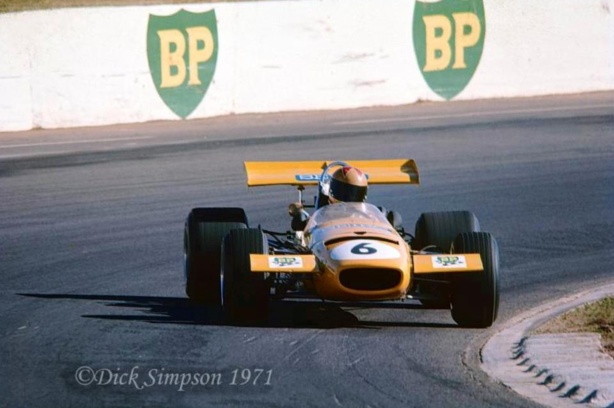
Max Stewart on the way to winning the ‘Angus & Coote Trophy’, the 1971 Oran Park Gold Star round on 27 June. Mildren Waggott 2 litre, Graeme Lawerence was 2nd in a Brabham BT30 FVC, the little cars succeeding as the F5000’s fell away (Dick Simpson)
Credits…
John Arkwright, oldracephotos.com, Dick Simpson, Dale Harvey, Bill Pottinger/The Roaring Season, Ian Smith, Neville McKay, autopics.com.au
Bibliography…
oldracingcars.com, F2 Register
Tailpiece: A Lotus to end an article on Brabhams…
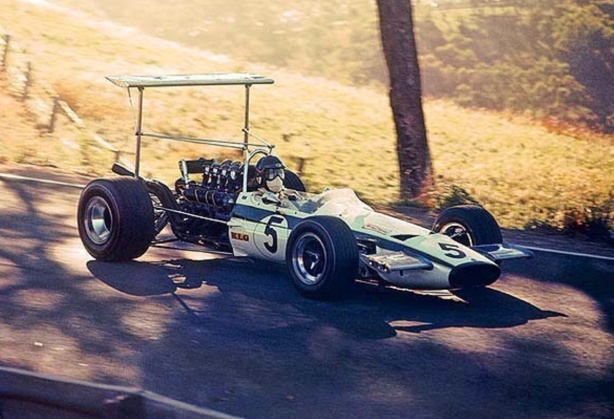
Leo Geoghegan’s Lotus 39 Repco with ‘830 series’ Repco V8, started from the Bathurst ’69 pole but out on lap 12 with a gearbox problem, his time would shortly come with this car, winning the JAF Japanese GP later in 1969 amongst a classy field (oldracephotos.com)
Click here for an article on this ex-Clark chassis;
https://primotipo.com/?s=lotus+39
Finito…






























